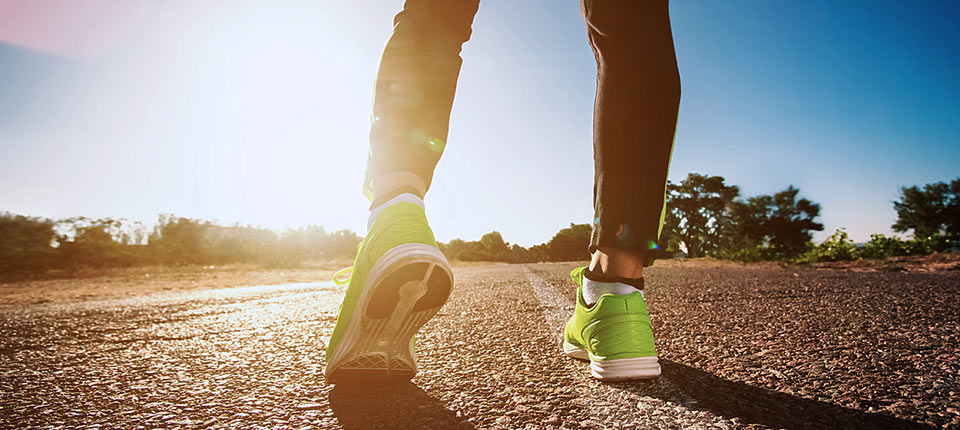
Endurance Exercise and Diabetes: Staying in Range
Diabetes shouldn't hold you back from achieving your goals. Learn how to maintain healthy glucose levels while participating in endurance exercise.
Apr. 17, 2019
- Copy Link
- Share on X
- Share on Facebook
- Share on Linkedin
BY ANA G REISDORF, MS, RD
So you've decided to challenge yourself and compete in an endurance event, such as a marathon, triathlon or bike race. You can easily find plans that will help you tackle these challenges, but most lack information on how to maintain healthy glucose levels and manage diabetes while training.
With a little bit of planning, there's no reason that diabetes should hinder your ability to partake in any activity — no matter how long it lasts.
Exercise and Blood Sugar
Regular exercise is a great way to maintain healthy glucose levels and make diabetes management a bit easier, because exercise improves insulin sensitivity, reduces insulin resistance and improves blood sugar levels. According to the Australasian Society of Immunology, physical activity for people with type 2 diabetes can lower inflammation and reduce body fat, which in turn normalizes metabolism and blood sugar. The American Diabetes Association says that aerobic exercises like running and cycling lower the risk of heart disease and mortality for people with all types of diabetes.
So you know that exercise is great for diabetes. But there are a few things to consider if you've signed up for an endurance activity.
Before You Start
The best thing to do before you even start training is talk to your doctor about your plans. Your doctor will provide you with several pieces of critical information for successful endurance training. Key points to ask about include:
- A general health assessment to determine if you are able to perform this type of activity.
- Exercise and blood sugar goals before, during and after activity.
- How often to monitor blood sugar during exercise.
- A plan for how to adjust medication and/or insulin, if necessary.
- Recommendations for what to eat, with a possible referral to a registered dietitian.
How to Start
You might feel the urge to dive right in, but it's important to start slow if you want to maintain a healthy blood sugar level and achieve your goal without injury. Intense exercise can increase your risk of low blood sugar, which can be dangerous.
Know the symptoms of hypoglycemia before you start. As outlined by the Mayo Clinic, symptoms can include:
- Dizziness.
- Fatigue.
- Pale skin.
- Sweating.
- Hunger.
If you feel any of these while exercising, stop and check your blood sugar.
As you begin training, be sure to monitor your blood sugar more often to learn about how your body reacts to increased exercise. Start by measuring your blood sugar before and after training sessions. Your levels can sometimes drop several hours after exercise, too, so you may also have to check more frequently post-workout. Your doctor can give you personalized guidance on how often you should check your levels.
For your first workout, try exercising indoors with your meter, lots of water and any necessary snacks nearby. Before you hit the open road, you'll want to see how your blood sugar will react. After you get a sense of how exercise will affect you, you can take your exercise outdoors.
It's also helpful to keep a journal that chronicles what you ate, how much you exercised and what your blood sugar levels were. You can share this with your doctor or dietitian and make changes to your plan as needed to keep your blood sugar stable.
Eating (and Drinking) for Endurance Exercise
Endurance athletes need more carbohydrates than non-athletes to help support the increase in physical activity. The Academy of Nutrition and Dietetics recommends a consistent intake of carbohydrates throughout the day to support exercise. Well-balanced meals with some protein and fat can also help sustain your energy and blood sugar during your training.
What you should eat before exercising will depend on your blood sugar level. If your sugar is between 70 and 100 mg/dL, you'll need to eat at least 15 grams of carbohydrates to bring it up a bit. An ideal snack for sustained energy prior to a workout contains some carbohydrates and protein — think half a turkey sandwich on wheat bread, or an apple with a slice of cheese.
After you exercise, you should eat something high in carbohydrates — such as whole grains, fruit or dairy — to avoid hypoglycemia. A banana is a great post-workout snack that can help ward off low blood sugar. Try to eat a balanced meal within two hours of working out, and choose something that includes a bit of protein, unsaturated fat and carbohydrates.
Troubleshooting
When you start training, you may have to spend a few weeks making adjustments to your diet, exercise plan and medication regimen to keep you safe and performing your best. Your doctor and dietitian are your best partners, and they can help you troubleshoot any challenges.
Remember to always put your safety first. Keep your meter close by, take snacks and water with you, and wear a medical bracelet if you are exercising alone. Over time, you will learn how your body reacts to the exercise — once you do, you can figure out how to meet any endurance goal.
For the latest on Abbott’s life-changing technology, get updates directly in your inbox.